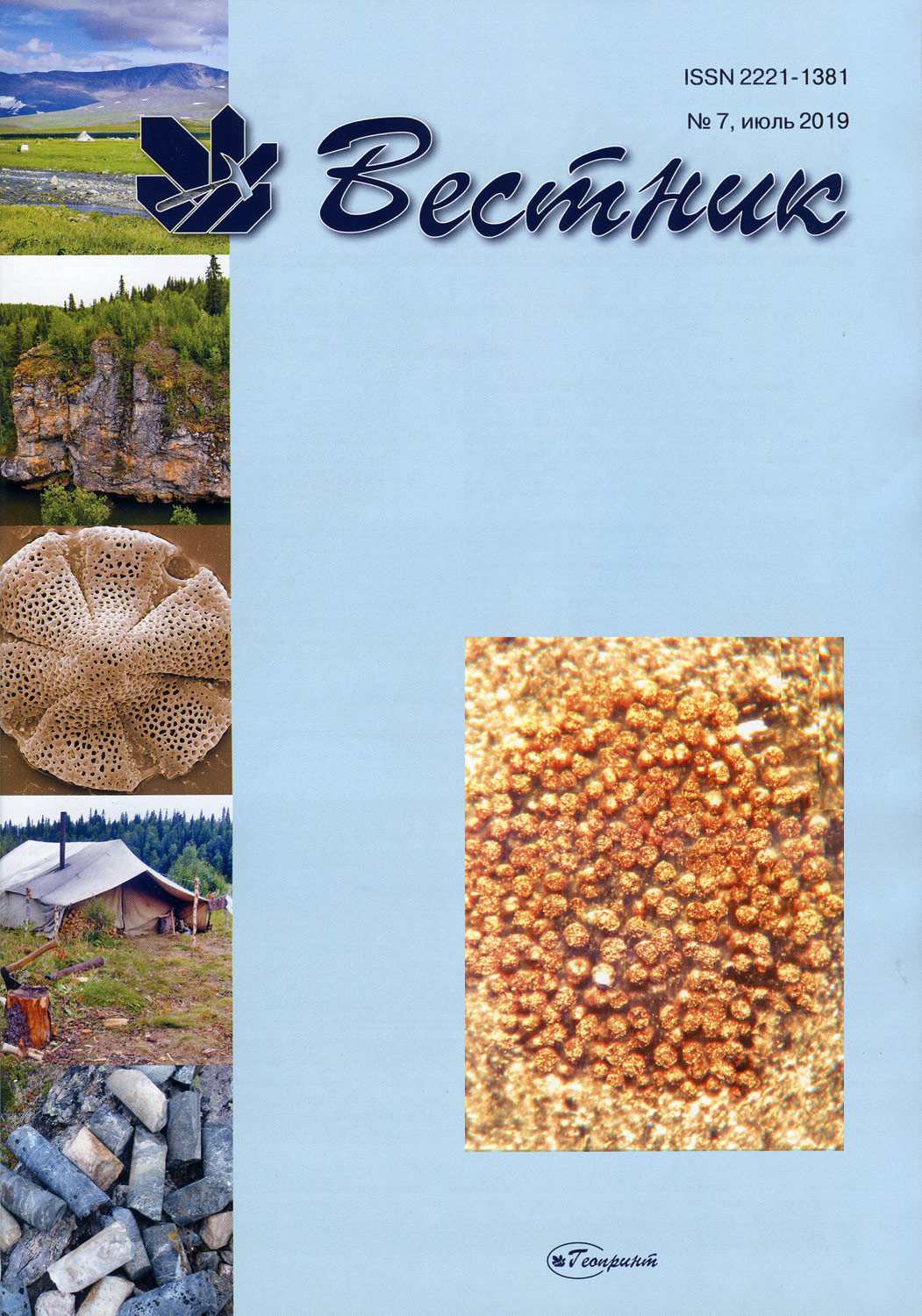pdf № 275, July
569 downloads

|
2 |
|
|
|
|
|
Scientific articles |
|
Carbon isotopic composition of Lower Paleozoic oils
|
3—7 |
|
DOI: 10.19110/2221-1381-2019-7-8-14 According to geological and geophysical data, two systems of faults are distinguished at the territory of European North of Russia – submeridional-sublatitudinal (N – S, W – E) and diagonal (NW – SE, NE – SW). On the northeastern of the Russian Plate, the Zimneberezhno-Krasnovishersky linear fault zone is most pronounced in geophysical fields, within which we were able to identify the intersection points of orthogonal deep faults: Zimnebrezhny, Vashkinsky and Zimstansky, which obviously have similar mineragenic specificity. At the territory of Timan-Pechora province, the Izhma-Pechora and Korotaikhinsky intersecting orthogonal faults are less clearly identified, which we named after their structural-tectonic affiliation. Reconnaissance geological and geophysical surveys were carried out within the newly allocated Zimstansky intersection site of orthogonal faults. Based on the interpretation of magnetic and gravimetric fields maps, cosmogeological maps and maps of fault tectonics, as well as the results of studies on the features of the deep structure of the consolidated crust of the Timan-Northern Urals region and adjacent territories of the Russian and West-Siberian plates in the volume of granite-gneiss and granulite of the metabasic structural-material complexes using geophysical data, we were able to identify the Zimnebrezhny, Vashkinsky and Zimstan junction points of orthogonal depths faults on the north-eastern of Russian plate, and within the Timan-Pechora – Izhma-Pechora and Korotaihinskoy. As a result of the detailed work carried out on the north-eastern outskirts of the Russian Plate (south of the Komi Republic), the location of the Zimstansky junction of deep orthogonal faults is localized and intense local gravimetric anomalies (Frolovskaya, Chetdinskaya and others) that are promising for the detection of the main bodies (alkaline - ultra basic (?)) composition in the production of detailed geological and geophysical works. Keywords: deep structure, tectonics, fault zones, anomalous of magnetic and gravitational fields, metalgenius. |
8—14 |
|
DOI: 10.19110/2221-1381-2019-7-15-24 The results of study of sulfide assemblages in altered gabbro Malyutka massif of South Urals Khudolaz differentiated complex were presented in this paper. This massif is a small olivine-hornblende gabbro stock containing Cu-Ni ores located in the footwall. The platinum group minerals (PGM) — michnerite and sperrylite — were found in the pyrrhotite, chalcopyrite, and pentlandite for the first time. We determined a significant influence of hydrothermal alteration on the ore occurrence. The ore forming process was subdivided into three types of the stages or assemblages: 1) magmatic type (pyrrhotite ± pyrite–chalcopyrite–pentlandite ± violarite + magnetite assemblage containing Rh-sperrylite and Pt-michnerite); 2) early hydrothermal type (pyrite ± pyrrhotite–chalcopyrite–violarite ± pentlandite + magnetite assemblage containing high Sb-michnerite); 3) late hydrothermal type (pyrite–chalcopyrite assemblage, PGE-mineralization not determined). Hydrothermal fluids were responsible for a small Fe and Cu loss from sulfides and further redeposition of these elements. Nickel and Co contents were increased in newly formed minerals such as pyrite and violarite. The first two types of assemblages were characterize of different michnerite composition: magmatic michnerite contained Pt (up to 3.2 %) and no Sb, whereas early hydrothermal michnerite displayed extremely high-Sb contents (up to 9.7 %) and a lack of Pt. Keywords: Khudolaz complex, Malyutka massif, hydrothermal processes, sulfide-platinum metal assemblages, michnerite. |
15—24 |
Mineralogical and spectroscopic features
|
25—32 |
Model experiments with multicomponent
|
33—42 |
Age of the upper part of the devonian tuffogeneous
|
43—48 |
About V. S. Tsyganko article
|
49—50 |
|
Chronicle, events, facts |
|
|
Isotope geochronoly – «queen» of geological sciences сelebrating |
51—52 |
- 8(8212)24-53-53
- institute@geo.komisc.ru
- Mon.-Fri. 8.00-17.00












